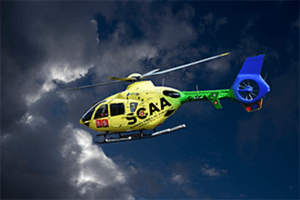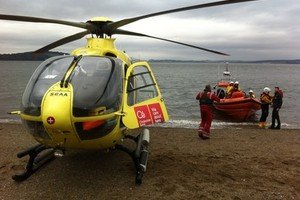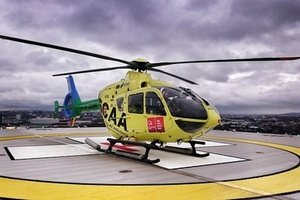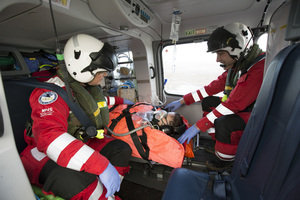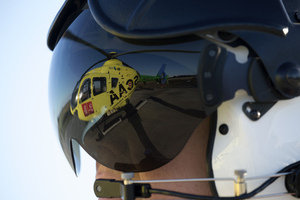
SCAA takes to the road for maximum impact
After 10 years in operation, Scotland's Charity Air Ambulance helicopters are now a familiar and welcome sight all across the country.
Less familiar to people perhaps - but equally important to the charity's life-saving mission - are SCAA's Rapid Response Vehicles, based at both its Perth and Aberdeen bases.
These state-of-the-art, hi-tech customised vehicles provide another vital asset in SCAA's fast-reaction life-saving capabilities - all funded by public donations.
Deployed primarily within a five mile radius of each base, the BMW F15 X5s allow paramedics to reach patients quickly in a blue light response which would prove faster by road than air.
Although unable to convey patients to hospital care, the road vehicles get paramedic care quickly to the scene of illness or injury which has proved a lifesaver time and time again.
And with SCAA's two road vehicles recording their busiest ever year in 2022, the value of these vital resources is apparent.
SCAA paramedics responded in the RRVs on 272 occasions during last year - an increase of 24% on the previous year's workload.
SCAA's Helimed 76 Clinical Paramedic Team Leader John Pritchard said the radius of operation for the vehicles could be extended on the very rare occasions the helicopter was offline for extreme weather or technical reasons.
"The RRVs play a key role in SCAA's response to emergencies," he said. "Every second counts in many cases and the BMWs prove a very fast response platform to local incidents. Having that capability has resulted in many lives saved over the years."

SCAA marks its tenth anniversary this year and John recalled the different vehicles which have served the charity in that time.
"We started with a Honda Civic, then a Kia before opting for a Skoda Octavia," he said. "In 2019 we upgraded to what has proved a real workforce for emergency services throughout the UK - the BMW X5."
It's what SCAA did with those basic frames, however, that resulted in one of the most advanced emergency response vehicles operating in Scotland today.
"The vehicles have been customised for our specific needs, creating the perfect operational road partner for SCAA paramedics and a highly effective emergency response service for the critical care of patients," explained John.
While highly branded, SCAA's RRVs comply with emergency services legislation in such standards as lighting and high intensity reflective materials which comply with the emergency services roads vehicles lighting regulations.
All SCAA paramedics are ambulance service emergency response drivers - refreshing their certification every five years - which basically equates to a civilian advanced driver in terms of capability.
"These are high-performance vehicles, customised to emergency services specifications and then tailored to SCAA paramedics' specific needs," said John.
A spacious interior allows the transport of all essential life-saving drugs and equipment for immediate treatment and resuscitation.
The very latest technology onboard offers paramedic support in areas such as electronic patient data transfer and information.
SCAA's bases at Perth and Aberdeen can find themselves at the heart of some pretty severe weather and both vehicles are kept free of ice and snow in the aircraft hangars overnight.
When the RRV is not in use, all battery operated equipment is kept fully charged at all times by means of an umbilical lead that connects to a wall mounted electric charger, ensuring vital kit including defibrillators, suction units, torches and mechanical CPR machines are good to go.
"We can take on some challenging weather conditions in these machines," said John. "They are four-wheel-drive, with all-season tyres fitted and a stock of extra blankets and snow shovels for good measure. We've been able to get through to people in need even when the weather's been at its worst."
In addition to responding to medical and trauma emergencies, the RRVs can also be pressed into service to recover crew and/or equipment from an incident scene and, at Perth, the vehicle has the distinction of also sporting an amber flashing light which is unique for responding to emergencies or operating on the airfield.
During 2022, 78 of the 272 RRV responses by SCAA were to cardiac-related emergencies (including 62 cardiac arrests).
A further 32 were to road traffic collisions and 27 to falls.
"The charity's remit is to save and improve lives and there is little doubt that our RRVs play a vital role in delivering that goal," said John. "Countless lives have been saved by SCAA paramedics using the charity's RRVs and working with emergency services colleagues and bystanders at the scene."
And John detailed one example to show the impact of their work.
"A recent cardiac arrest emergency saw SCAA deploy rapidly to the scene, work with Scottish Ambulance Service ambulance crew colleagues, utilise the mechanical CPR machine, deliver two shocks on the defibrillator and achieve a spontaneous pulse," he said. "The patient was sitting up chatting by the time the team finished their paperwork."

